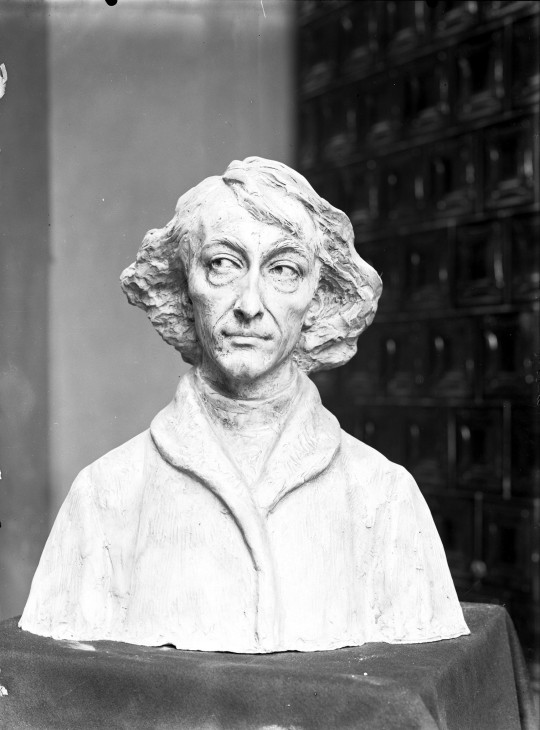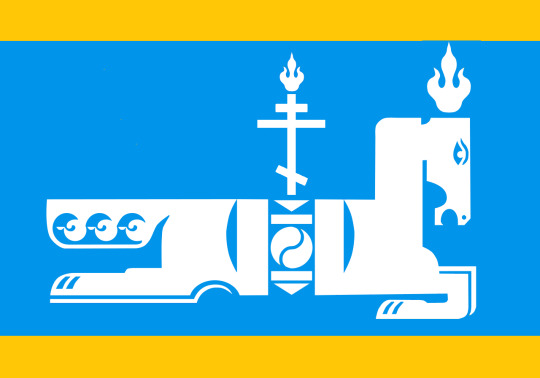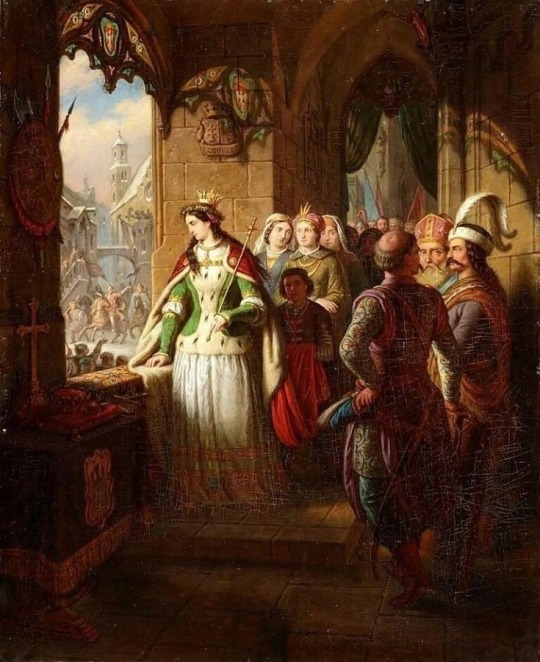#kingdom of poland
Text

Nicolaus Copernicus (Konstanty Laszczka, Polish sculptor)
Happy birthday, Nicolaus Copernicus!
Nicolaus Copernicus (February 19, 1473 — May 24, 1543) is primarily known as an exceptional astronomer who formulated the true model of the solar system, which led to an unprecedented change in the human perception of Earth’s place in the universe. This great Pole, who is rightly included among the greatest minds of the European Renaissance, was also a clergyman, a mathematician, a physician, a lawyer and a translator. He also proved himself as an effective strategist and military commander, leading the defence of Olsztyn against the attack of the German Monastic Order of the Teutonic Knights. Later on, he exhibited great organizational skills, quickly rebuilding and relaunching the economy of the areas devastated by the invasion of the Teutonic Knights. He also served in diplomacy and participated in the works of the Polish Sejm.
Copernicus’ scientific achievements in the field of economics were equally significant, and place him among the greatest authors of the world economic thought. In 1517 Copernicus wrote a treatise on the phenomenon of bad money driving out good money. He noted that the“debasement of coin” was one of the main reasons for the collapse of states. He was therefore one of the first advocates of modern monetary policy based on the unification of the currency in circulation, constant care for its value and the prevention of inflation, which ruins the economy. In money he distinguished the ore value (valor) and the estimated value (estimatio), determined by the issuer. According to Copernicus, the ore value of a good coin should correspond to its estimated value. This was not synonymous, however, with the reduction of the coin to a piece of metal being the subject of trade in goods. The ore contained in the money was supposed to be the guarantee of its price, and the value of the legal tender was assigned to it by special symbols proving its relationship with a given country and ruler. Although such views are nothing new today, in his time they constituted a milestone in the development of economic thought.
Additionally Copernicus was not only a theorist of finance, but he was also the co-author of a successful monetary reform, later also implemented in other countries. It was Copernicus, the first of the great Polish economists, who in 1519 proposed to King Sigismund I the Old to unify the monetary system of the Polish Crown with that of its subordinate Royal Prussia.
The principles described in the treatise published in 1517 were decades later repeated by the English financier Thomas Gresham and are currently most often referred to around the world as Gresham’s law. Historical truth, however, requires us to restore the authorship of this principle to its creator, for example through the popularization of knowledge about the Copernicus-Gresham Law. (© NBP - We protect the value of money).
#nicolaus copernicus#mikołaj kopernik#sculpture#poland#science#konstanty laszczka#scienceblr#scientists#science academia#astronomy#thomas gresham#science history#renaissance#16th century#polish artist#study inspiration#solar system#planets#prussia#kingdom of poland#*
257 notes
·
View notes
Text

King Stanislaus Augustus Poniatowski. Unknown artist.
13 notes
·
View notes
Text

Saint Casimir (1458-1484), prince and patron saint of Poland. Attributed to Agostino Masucci.
He was the third child and the second son of the King of Poland and Grand Duke of Lithuania Casimir IV and Queen Elisabeth Habsburg of Austria.
#agostino masucci#saint casimir#saints#catholic church#patron saint#kingdom of poland#Korona Królestwa Polskiego#Królestwo Polskie#Jagiellonian dynasty#Jagiellonowie
9 notes
·
View notes
Text

Mieszkańcy Polski z XIX-XX wieku. Wg kościoła wygląda na wschodnią Polskę, wg pocztówki jest to królestwo Polskie, czyli po odzyskaniu niepodległości w 1918 r.
#Królestwo Polskie#Kingdom of Poland#people#ludzie#mieszkańcy#wschód#east#pocztówka#kartka#post card#postcard#widokówka
0 notes
Text



Soon
#countryhumans#countryhumans usa#polandball#countryhumans russia#countryhumans france#countryhumans united kingdom#countryhumans china#countryhumans canada#countryhumans new zealand#countryhumans portugal#countryhumans poland
1K notes
·
View notes
Photo






Instagram credit: myphotography_com
#warsaw#poland#lisbon#portugal#paris#france#saint pearl#london#england#united kingdom#europe#visit europe#beige tones#beige aesthetic#streets#street#brown aesthetic#brown tones#travelling#travel
2K notes
·
View notes
Text

It doesn't matter what your nationality is, those Hell Dwellers will kill you if you have humanity.
#save palestinians#support palestine#pray for palestine#save palestine#palestine news#palestine#from the river to the sea palestine will be free#war on gaza#gaza genocide#free gaza#gazaunderattack#gaza strip#gaza#stop the genocide#stop genocide#genocide#israel is an apartheid state#israel is a terrorist state#stop israel#fuck israel#boycott israel#israel#biden administration#joe biden#biden#fuck america#usa news#australia#poland#united kingdom
76 notes
·
View notes
Text
Was bored and decided to draw in a more countryhuman like art style😭😭

This is prolly how i will draw on my ohone from here on hahahahha..😊
#countryhumans#country humans#art#tumblr art#artists on tumblr#digital art#countryhumans art#countryhuman#countryhumans greece#countryhumans poland#countryhumans united kingdom#countryhumans serbia#countryhumans greenland#countryhumans finland#countryhumans ukraine#countryhumans australia#countryhumans czechia#countryhumans antarctica
322 notes
·
View notes
Text
Hi

#shitpost#our art#countryhumans ussr#countryhumans Serbia#countryhumans Czechoslovakia#countryhumans kingdom of serbia#countryhumans poland#countryhumans Montenegro#countryhumans china#countryhumans Bosnia#countryhumans belarus
54 notes
·
View notes
Text
doodle page #1

#pohon art tag#countryhumans#countryballs#everyone is male#except for n. ireland and wales#n. ireland is a female while wales doesnt rlly have a gender#france#united kingdom#germany#poland#indonesia#united states of america#canada#china#russia#italy#vatican city#san marino#ireland#northern ireland#england#scotland#wales#mexico#malaysia#philippines#singapore#brunei darussalam#idk how to tag a ch post
26 notes
·
View notes
Text
Flag of the Kingdom of Mongolia

This is the flag of the Kingdom of Mongolia. It comes from a world where China successfully repelled the Mongols early on. As a result, the Mongol Empire never came to be. The Mongols continued to be pushed farther and farther west until they arrived in Eastern Europe. Eventually, they settled around where Romania and southern Poland are in our world. Thus, the Kingdom of Mongolia was born. The Mongols were frequently visited by Byzantine missionaries, and the Mongolian Orthodox Church is the official state religion. The Byzantine Empire also remains a major trading partner for Mongolia. In more peculiar alliances, Mongolia is also a major ally of the tiny mountainous nation of Neo Hellas, the final remnant of pagan Greece.
The coming of the Mongols altered the migration patterns of several other peoples. For example, the Bulgars settled in Russia, establishing the Czardom of Bulgaria. Meanwhile, several Germanic tribes invaded Greece, and Byzantium is currently ruled by a Germanic dynasty. Islam was still founded, but it never expanded beyond the Arabian Peninsula.
In terms of bad relations, Mongolia has always had a very tense relationship with the Franco-Saxon Kingdom. Throughout the years the Franco-Saxons have repeatedly attempted to conquer the Mongolians. Even after all these years, Mongolia remains bitter about the Franco-Saxon invasion that occurred during the Second Great Patriotic War. Despite this, in more recent times there has been increasing emphasis on moving on and letting go of the past. Younger generations in particular are more likely to support reconciliation between the two nations.
Mongolia takes pride in its dual mature of East Asian heritage and Eastern European culture. The flag reflects this dual heritage. The blue recalls both the cloak of the Virgin Mary and the eternal blue sky of the Tengrism. The horse symbolizes the nomadic past of the Mongolian people, before they settled in Eastern Europe. The cross represents the Mongolian Orthodox Church, with the flame representing the flames of Pentecost. The interlocking circles halves represent the dual nature of the Mongolian people. The golden bands represent the hope that the Mongolian people will always prosper no matter what life throws at them. They also help to offset the blue on the main body of the flag.
https://drakoniandgriffalco.blogspot.com/2019/03/flag-of-kingdom-of-mongolia.html?m=0
#alternate history#alternate history flag#alternate history flags#vexillology#flag#flags#mongolia#Kingdom of Mongolia#Flag of the Kingdom of Mongolia#Romania#Poland#ukraine#moldova#eastern europe#Mongols#alt history
36 notes
·
View notes
Note
Us 🥰

110% 🥰
#DID YOU KNOW that Finland has only gotten 12 points in 1977 2006 and 2011?#and that when Czechia first took part they got three last places in a row and withdrew?#and that Poland's and Serbia's first entries are their most successful ones?#and that Finland and Ukraine have never been in the same semi final?#and that the United Kingdom has 16 second places??#follow for more obscure facts nobody asked for#asks#eurovision
66 notes
·
View notes
Text

Portrait of Maria Countess Walewska (1786-1817). By Jean Baptiste Isabey.
#jean baptiste isabey#królestwo polskie#polish aristocracy#maria walewska#royal mistresses#kingdom of poland#french empire#dynastie bonaparte#maison bonaparte
7 notes
·
View notes
Text

Queen Jadwiga looking at the entry of Lithuanian Grand Duke Jagaila into Krakow. By Alexander Lesser.
12 notes
·
View notes
Text
The Israeli occupation forces force displaced people near an UNRWA school to carry weapons to prove that they are gunmen handing themselves to occupation forces in Gaza.
#palestine#free palestine#gaza#humanity#save palestine#fuck israel#israel is evil#israeli apartheid#boycott israel#israel is a terrorist state#uk#united kingdom#united states#usa#america#poland#armenia#ukraine#russia#czech#czechia#canada#china#korea#world#important#palestinians lives matters
14 notes
·
View notes
Text

Do you agree?
#israel#gaza#nature#news#photography#palestine#aesthetic#israël#trending#viralpost#viral trends#united states#united kingdom#poland#china
10 notes
·
View notes